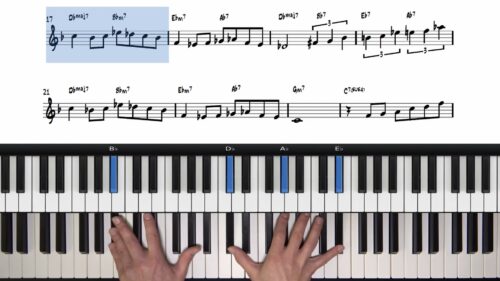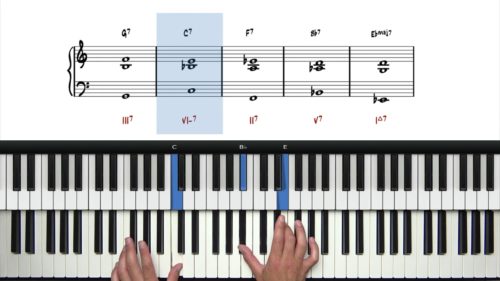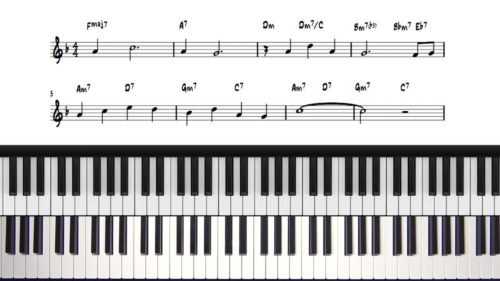B & C Sections: Stride & Shells
In this lesson we will work through the second half of the tune introducing the melody into our arrangement. We will identify areas where it’s appropriate to apply a left-hand stride and also areas where a simpler voicing configuration could be a more suitable choice.
Personalising The Melody
When playing jazz standards we have the freedom to change the melody. In this lesson I demonstrate how we can hold back the melody or push the melody notes forward compared to what is shown on the lead sheet. Listen to different vocal versions of this tune and you’ll hear many different ways that we can phrase the melody to add more interest and personality to our arrangement.
Working From Lead Sheets
Always remember that when working from lead sheets, what you see on the score is not a ‘set-in-stone’ arrangement. We always have the creative freedom to change the placement of the melody.
Lesson Downloads
-
Bridge Transition & B Section Voicings File Type: pdf
Practice Tips
-
Intertwine the stride left hand pattern with occasional shell and spread voicings to create a more varied accompaniment and arrangement.
-
Always keep in mind the melody and the harmony which can help you to determine the most suitable choice of voicing structure in your left hand.
-
Outline the quarter beat with your left hand when playing spread and shell voicings to help create a steady pulse as you play through the tune.









Hello Hayden,
Wath is the harmonic analysis of the Eb7 chord at the measure 15 ?
Kind regards
Véronique
Hi Véronique,
Great question!
The Eb7 is functioning as a “flat 7 dominant chord” which is basically a dominant chord built from the b7 of the key.
This is commonly referred to as the “Backdoor 251 Progression”.
In the key of F major, the 7th degree would be E natural, and the flat 7 would be Eb.
The “Backdoor 251 Progression” is quite a complicated relationship to explain, but the main point is that Eb7 has the same harmonic tendencies as C7 which is the V7 chord in the key of F major, and so Eb7 can be used to approach Fmaj7 which is what is happening in bar 15. It creates a little tension and then release.
To quickly explain how the relationship works:
If we take a rootless C7 chord with a b9, the notes would be E-G-Bb-Db. This is also a diminished chord.
If we take a rootless Eb7 with a b9, again the notes would be G-Bb-Db-E – this is the relationship I am talking about.
Those same 4 notes can function as 4 rootless b9 dominant chords (C7b9, Eb7b9, Gb7b9, and A7b9).
I created a lesson on this recently in my blues course, check it out here:
pianogroove.com/blues-piano-lessons/backdoor-251-progression/
Here’s a lesson on a related topic by Tuomo: pianogroove.com/jazz-piano-lessons/the-4-minor-chord/
Finally, here is a forum post where I explain the Backdoor 251 Progression in a little more detail and show examples of where is appears in many songs: community.pianogroove.com/t/over-the-rainbow-harmonic-analysis/2668/16
Please check out the lessons and links above and let me know if you have any more questions.
Talk soon,
Hayden
Thanks a lot Hayden for this answer. I will check out the related courses.
It is not so easy to understand because my langage is french, but I think I have understood What you mean.
Have a nice day.
Best regards
Véronique